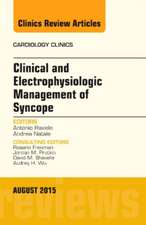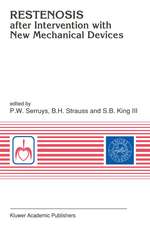Cardiac Arrhythmias 2003: Proceedings of the 8th International Workshop on Cardiac Arrhythmias
Editat de Antonio Ravieleen Limba Engleză Hardback – 9 oct 2003
| Toate formatele și edițiile | Preț | Express |
|---|---|---|
| Paperback (1) | 1049.48 lei 38-44 zile | |
| Springer – 4 noi 2012 | 1049.48 lei 38-44 zile | |
| Hardback (1) | 1135.03 lei 6-8 săpt. | |
| Springer – 9 oct 2003 | 1135.03 lei 6-8 săpt. |
Preț: 1135.03 lei
Preț vechi: 1194.76 lei
-5% Nou
Puncte Express: 1703
Preț estimativ în valută:
217.22€ • 225.94$ • 179.32£
217.22€ • 225.94$ • 179.32£
Carte tipărită la comandă
Livrare economică 12-26 aprilie
Preluare comenzi: 021 569.72.76
Specificații
ISBN-13: 9788847002319
ISBN-10: 8847002311
Pagini: 948
Ilustrații: XXV, 921 p.
Greutate: 1.43 kg
Ediția:2004
Editura: Springer
Colecția Springer
Locul publicării:Milano, Italy
ISBN-10: 8847002311
Pagini: 948
Ilustrații: XXV, 921 p.
Greutate: 1.43 kg
Ediția:2004
Editura: Springer
Colecția Springer
Locul publicării:Milano, Italy
Public țintă
ResearchDescriere
The field of cardiac arrhythmias has been evolving so fast during the last years that scientific meetings are frequently necessary to present technological advances, to communicate results of relevant and innovative researches, to assess the impact of recently developed diagnostic and therapeutical tools, to discuss controversial aspects, and to reach a consensus on the most appropriate evaluation and management of specific problems. This is the main reason why in 1988 we started to organize a biannual International Workshop on Cardiac Arrhythmias. Since then many editions of the workshop have taken place and over the years the fame and popularity of the event have increased continuously. This book contains the Proceedings of the Eighth Edition of the Workshop th th held in Venice at the Fondazione Giorgio Cini from the 5 to the 8 of October 2003. During the meeting all the principal aspects of the different arrhythmias, from epidemiology to physiopathology, electrogenetic mechanisms, diagnosis, prognosis, treatment, pshycological implications and economic costs have been discussed among the numerous experts and participants.
Cuprins
Defining anatomic structures: when and why is it important?- Ablation of atrial fibrillation: what are the true advantages?- Ablation of ventricular tachycardia: may the current results be improved by intracardiac echocardiography?- Risk stratification and prevention of thromboembolism: which role for intracardiac echocardiography?- Intracardiac echocardiography: what are the future expectations?- Legs crossing and muscle tensing to abort vasovagal syncope: a novel effective treatment?- Isometric arm contraction at the onset of prodromal symptoms: a new first-line treatment for vasovagal syncope?- Patient-activated implantable drug pump for treatment of vasovagal syncope: is it time for clinical use?- Hemodynamic assessment with implanted pacemakers: how feasible and reliable is it?- Hemodynamic sensors: what is the impact in the clinical practice?- Hemodynamic sensors: can they ensure physiological rate control?- Trans-valvular Impedance: does it allow automatic capture detection?- Palpitations of unknown origin: how frequent is a supraventricular tachyarrhythmia as cause?- Complex supraventricular tachycardias: what is the role of alternative technologies?- Vasovagal syncope, orthostatic hypotension and POTS: which relationship?- Distinguishing syncope from seizure: how useful is the clinical history?- Unexplained syncope: can we predict the outcome of implantable loop recorder?- What are the perfusion and adrenergic innervation of the left ventricle in paced patients?- How does left ventricle remodel after long-term single or dual ventricle cardiac pacing?- Acute termination of atrial flutter: class III drugs or transesophageal pacing?- Class I C / Amiodarone atrial flutter: what are the long-term results of cavo-tricuspid isthmus ablation?- Atypical atrial flutter: how to locate and ablate the reentry circuit?- How to diagnose, locate and ablate coronary cusp ventricular tachycardia?- Drug-induced torsade de pointe: a fruste form of congenital long QT syndrome?- Which drug to prefer in the different clinical conditions?- 'Sympathetic' and 'vagal' atrial fibrillation: do they exist?- Predicting atrial fibrillation in hypertension: are we able?- Is the cause of arrhythmogenic right ventricular cardiomyopathy congenital or acquired?- Frequent monomorphic right ventricular premature beats: are they an early manifestation of arrhythmogenic right ventricular cardiomyopathy?- Is ICD implantation useful in patients with arrhythmogenic right ventricular cardiomyopathy?- New evidence from the secondary endpoints of the MADIT II study.-What is the real economic impact of MADIT II study on the European medical community?- Diagnosis of neurally mediated syncope: may implantable loop recorder replace tilt table test?- To pace or not to pace for neurally mediated syncope: do we know the answer?- Waveform flexibility: will it be the solution for future shocks?- Sleep apnea: which new insights?- 'Pill' in the pocket strategy for treatment of atrial fibrillation recurrences: how effective and safe is it?- Cardioversion of recent-onset atrial fibrillation: which drug to prefer in the single patient?- Pretreatment with antiarrhythmic drugs: is it useful to avoid immediate and early post-cardioversion recurrences?- Does the policy of repeated early cardioversion for recurrences of atrial fibrillation work?- Electrical cardioversion of atrial fibrillation: how to improve the outcome?- What is the prevalence, incidence and prognostic value of Brugada-type electrocardiogram in the general population?- Brugada syndrome or Brugada mimicry?- Ventricular tachycardia or conduction disease: what is the mechanism of death in Brugada syndrome?- What are the keys for the hemodynamic improvement in heart failure patients?- AV Delay in heart failure pacing: how to manage it?- Heart failure therapy driven by implantable sensors: what might be expected?- How to manage atrial fibrillation in patients with congestive heart failure?- ACE inhibitors and angiot
Caracteristici
The book represents an update on epidemiological, electrogenetic, diagnostic, prognostic and therapeutic aspects of cardiac arrhythmias


















